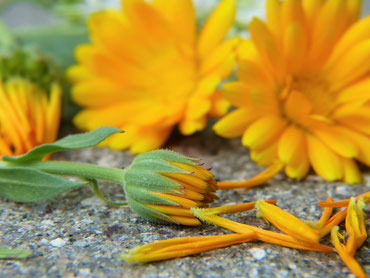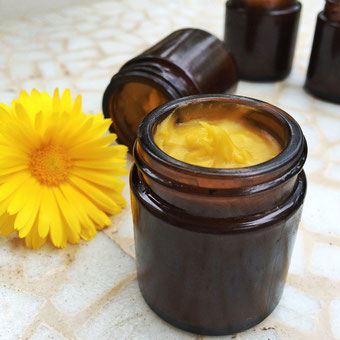
Dear reader, meet Clara the herbwoman: She's the midwife and healer in a rustic little village in the midst of miles and miles of nothing but fields and forests.
Winter is drawing to a close, but it's still cold out, and the farmers are starting to ready their tools for the coming planting season. The farmers' hands are roughened by the cold weather,
and their skin is starting to chafe and split, even as those hands are needed to do fiddly repairs on tools or to sew new clothes for the coming spring.
Many a farmer will call on Clara to find a salve to soothe the skin, to enable those much-abused hands to do the necessary chores. Thus, today we find Clara stirring herbs into her cauldron, to cook up the salve the farmers will need. Let's watch over her shoulder while she assembles her ingredients on her wooden kitchen table:
- Several bunches of fresh-cut basil, harvested from one of the pots Clara keeps on her window sill all winter.
- A jar of calendula oil she's prepared by macerating calendula flower petals in sunflower oil, which she's let steep on a shelf by the oven for the last six weeks.
- Clarified butter that she's rendered from the fresh butter one of her patients has bartered for her services last week.
- Beeswax from her own beehive out in the kitchen garden.

Clara cuts the basil up to free up the essential oil it contained in its leaves. Then she melts the clarified butter and stirs the basil in.
For the next half hour, she stirs the butter over slow heat, taking care to never let her concoction get hot enough to bubble. Then she empties the potion through a fine-woven cloth into a glass jar, filtering out and discarding the steeped-out basil.
Clara stirs the macerated calendula oil into the still-liquid butter, cuts up some beeswax and stirs that in, too, and heats up the potion in a water bath--still taking care not to let it get too hot--until the wax melts. Once that's done, she decants the potion into small jars and lets it cool until the potion congeals to a soft salve.

Tomorrow, she'll have a new batch of healing salve to hand out to her patients. Due to the calendula oil it contains, the potion has anti-inflammatory properties and expedites wound-healing. It also has a mild antimicrobial effect, and inhibits some dermatophytes' growth. Basil is also said to have anti-inflammatory, anti-fungal and antimicrobial effects, and it lends the salve a fresh scent. The clarified butter will be absorbed into the skin and moisturize it, while the wax will provide a protective film on top of Clara's patients' skin, protecting their hands from the cold and dry air.
While basil has largely fallen out of use in modern medicine except for folk medicine such as Ayuverda or traditional Chinese medicine, some research exists showing that calendula does indeed help wounds heal faster. Calendula is also a common ingredient in modern skin care products.
Thus, Clara's salve will work in real life as well as for her fictional patients--and in fact, it is a key ingredient in this author's own medicine chest.
*** Please note: This blog is not intended as medical advice. ***
Do not try this at home.
(Or at least, don't use any of the remedies described here this without consulting your physician first.)
